Subscribe now and get the latest podcast releases delivered straight to your inbox.
How To Skillfully Write About Competitors On Your Blog

Feb 20, 2023

Coke has Pepsi. McDonald's has Burger King. Apple has Android.
As much as every business would like to believe it's a unique snowflake in its market, it almost always has competitors — and prospective buyers want to know how they stack up.
Rather than run from the comparisons, confronting your competition head on should be an integral part of your content strategy.
I know what you're thinking: "Why would I ever talk about my competitors? I want people focused on my options, not theirs."
Well, for one, people are going to think about your competitors whether you like it or not. In fact, 65% of buyers report spending at least 16 minutes comparing options before making a purchase.
Embracing this buyer behavior will help you get in front of your target audience when they're weighing their options, guide the conversation surrounding the comparison, and build trust as the expert who provided the answer your buyer was looking for.
Over the years, IMPACT has trained hundreds of businesses around the world create high quality, traffic and lead-driving content about their competitors. In this article, we will guide you to do the same.
Why write about the competition?
At first glance, talking about your competitors might seem counterintuitive, but over the years, we've found the companies that recognize and acknowledge their competition ultimately fare better than those that don't.
Here's why.
1. You'll build trust with your audience
No business exists in a silo. Creating content about your competitors shows prospective buyers that you are aware of your surroundings and recognize what's going on in a buyer's head.
You're not naive. You're not ignoring the fact that buyers have other options and will wonder about them. You're actually acknowledging these natural thoughts and helping resolve them.

Now, this doesn't mean you have a license to bash your competition. Buyers can see right through that.
The key is to deliver the facts about your competition — their products, services, weaknesses, and strengths.
Most consumers have never had a company inform them honestly about their other options, much less offer transparency into their own competitive analysis.
Doing so shows integrity. It shows that they can trust you have your buyer's best interests in mind. You're not simply trying to sell anyone you can.
2. You'll expand your organic reach
Writing content about your competitors may have you going after keywords that would typically send traffic directly to your competitors’ websites or third-party review sites.
Think of Engage Bay's article "HubSpot Pricing and Comparison with Affordable Alternatives." Engage Bay, like HubSpot, is an all-in-one platform for marketing, sales, and support teams.
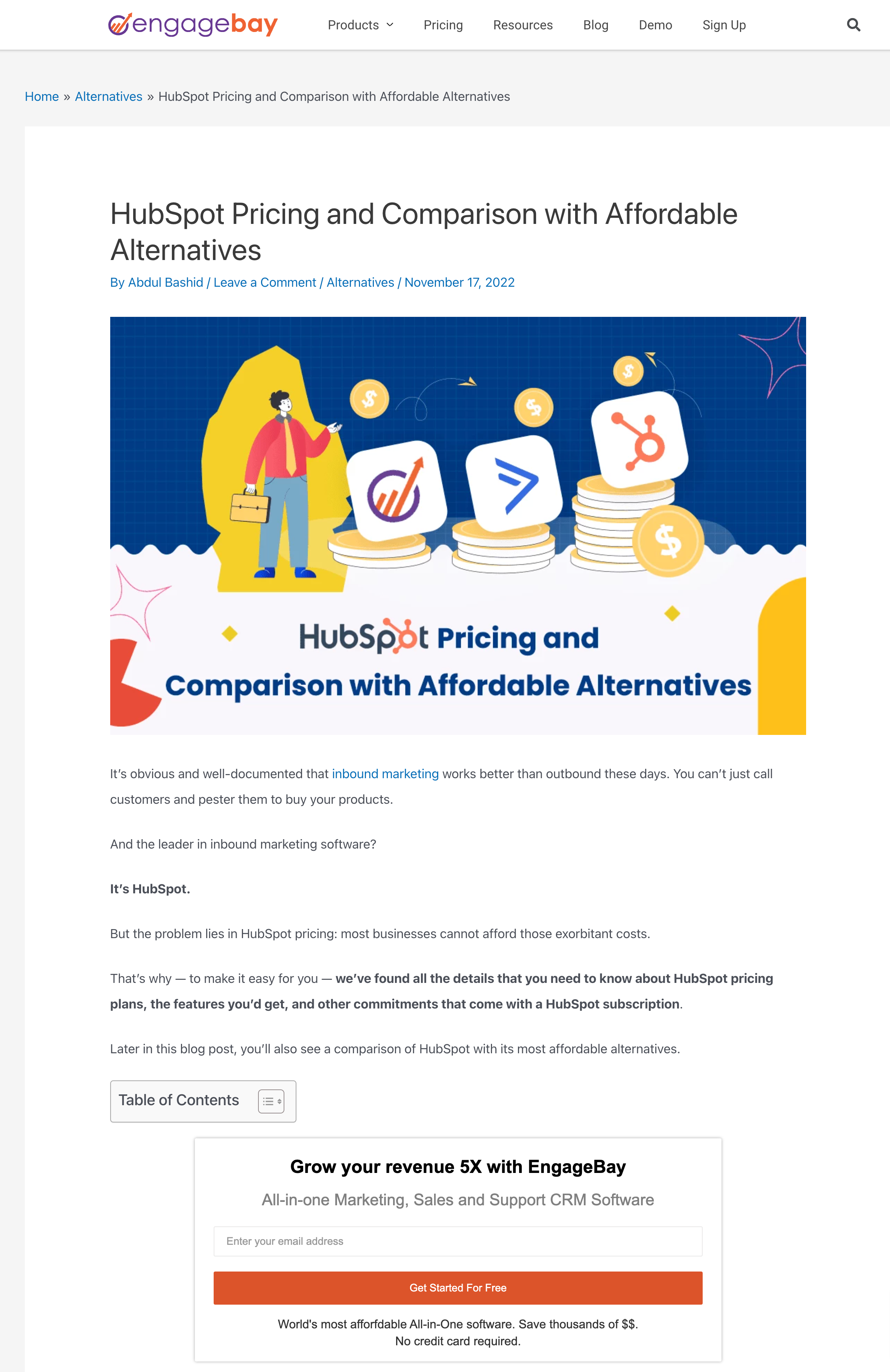
When a prospect searches for something like "HubSpot Pricing" there’s a good chance they are in the decision stage of their buyer’s journey and want to know more about HubSpot before making a final decision.
Many may not even know Engage Bay is the same market.
After finding this article, however, they do.
Answering questions around competitors and having prospects come to your site gives you a chance to introduce your product or service as an option. This helps you expand your reach and perhaps even get some new people in your pipeline.
3. You get to control the conversation
Addressing how other businesses could potentially help with your buyer's problem too, allows you to control the conversation surrounding them.
Again — this doesn't mean bashing your competitors.
You need to remain fair and unbiased; otherwise prospects will know you’re just trying to persuade them away from the competition otherwise.
However, you can still choose what facts you share and which you don't. Creating content around your competitors also gives you more power to insert yourself into the conversation more naturally for direction comparison.
Look at the earlier example from Engage Bay, for instance. In the introduction, Engage Bay writes:
"And the leader in inbound marketing software?
It’s HubSpot.
But the problem lies in HubSpot pricing: most businesses cannot afford those exorbitant costs.
That’s why — to make it easy for you — we’ve found all the details that you need to know about HubSpot pricing plans, the features you’d get, and other commitments that come with a HubSpot subscription.
Later in this blog post, you’ll also see a comparison of HubSpot with its most affordable alternatives."
They make it clear that they're going to deliver the information you're looking for, but will also dive into some discussions you may not have considered and offer guidance.
(Note: Yes, they are one of the suggested alternatives.)
How to write about competitors on your business blog
1. Pick your approach
There are a few options for creating content around competitors:
- Answering direct questions about your competitors
- Best-of competitor lists
- Direct competitor comparison
Answering direct questions about competitors
Answering direct questions about competitors is like our example around "HubSpot pricing." It allows you to go after traffic looking for more information about your competitor but also to control the conversation and introduce yourself as an expert and alternative.
Best-of competitor lists
In recent years, searches for "best" products has increased dramatically. That's why the best-of competitor list is so valuable.
With this, you’re targeting searches where people want to see all of their best options for a particular solution. (i.e. The best mid-sized cars, the best Indian restaurants in Phoenix, the best video editing tools). Essentially, you’re performing competitive analysis and then publishing the results.
IMPACT client Intek Logistics’ competitor articles are the top drivers of sales-qualified leads. They’ve written several competitor articles for each service they provide, and the results look a lot like what you see below:
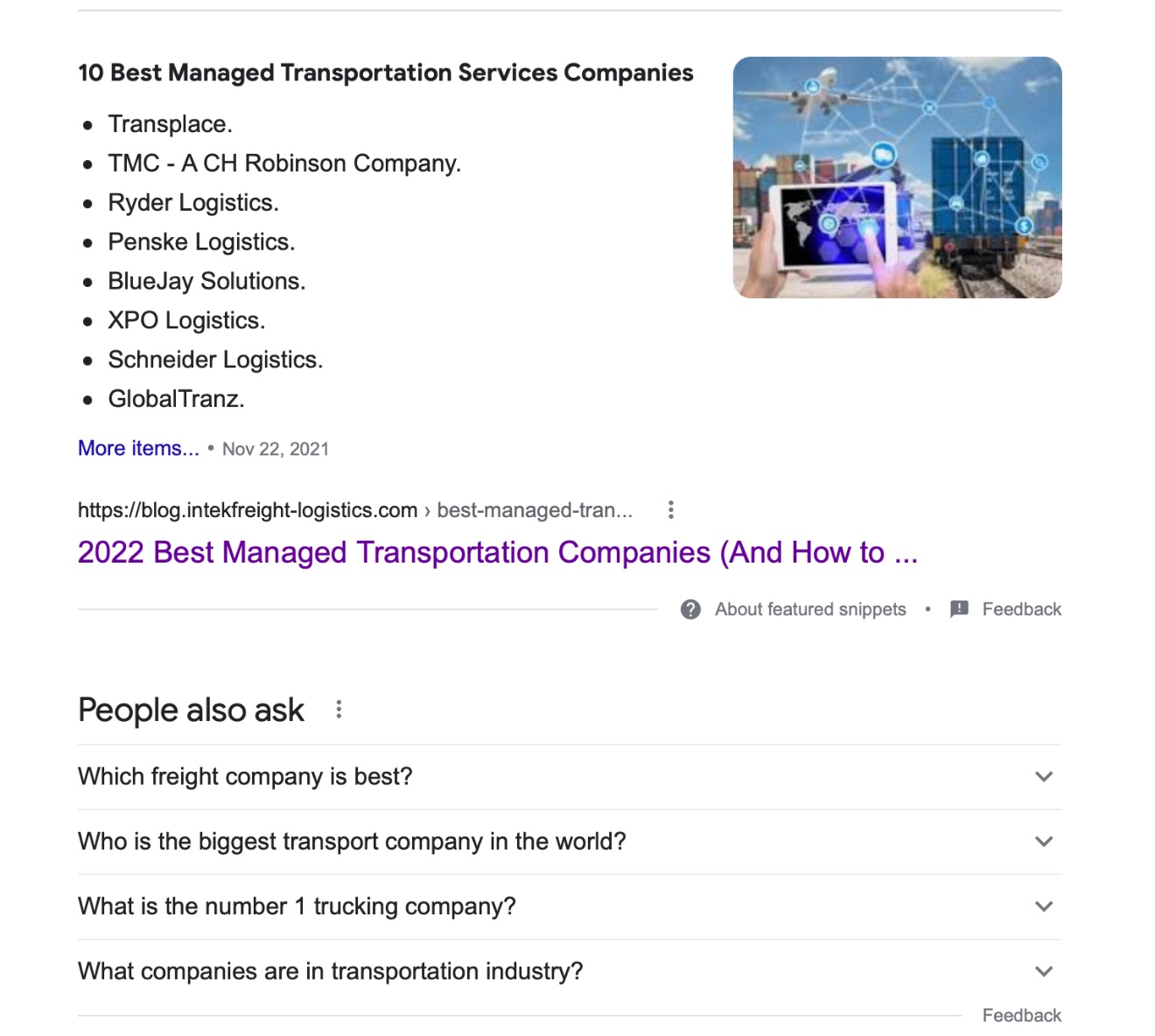
As you can see, Intek is the first result and has the coveted featured snippet for the query “best transportation companies.”
Director competitor comparison
Last, the direct competitor comparison is for people who have seriously weighed their options and are struggling to choose between a small handful of choices.
These are likely direct comparisons like HubSpot's "Salesforce vs HubSpot" page.
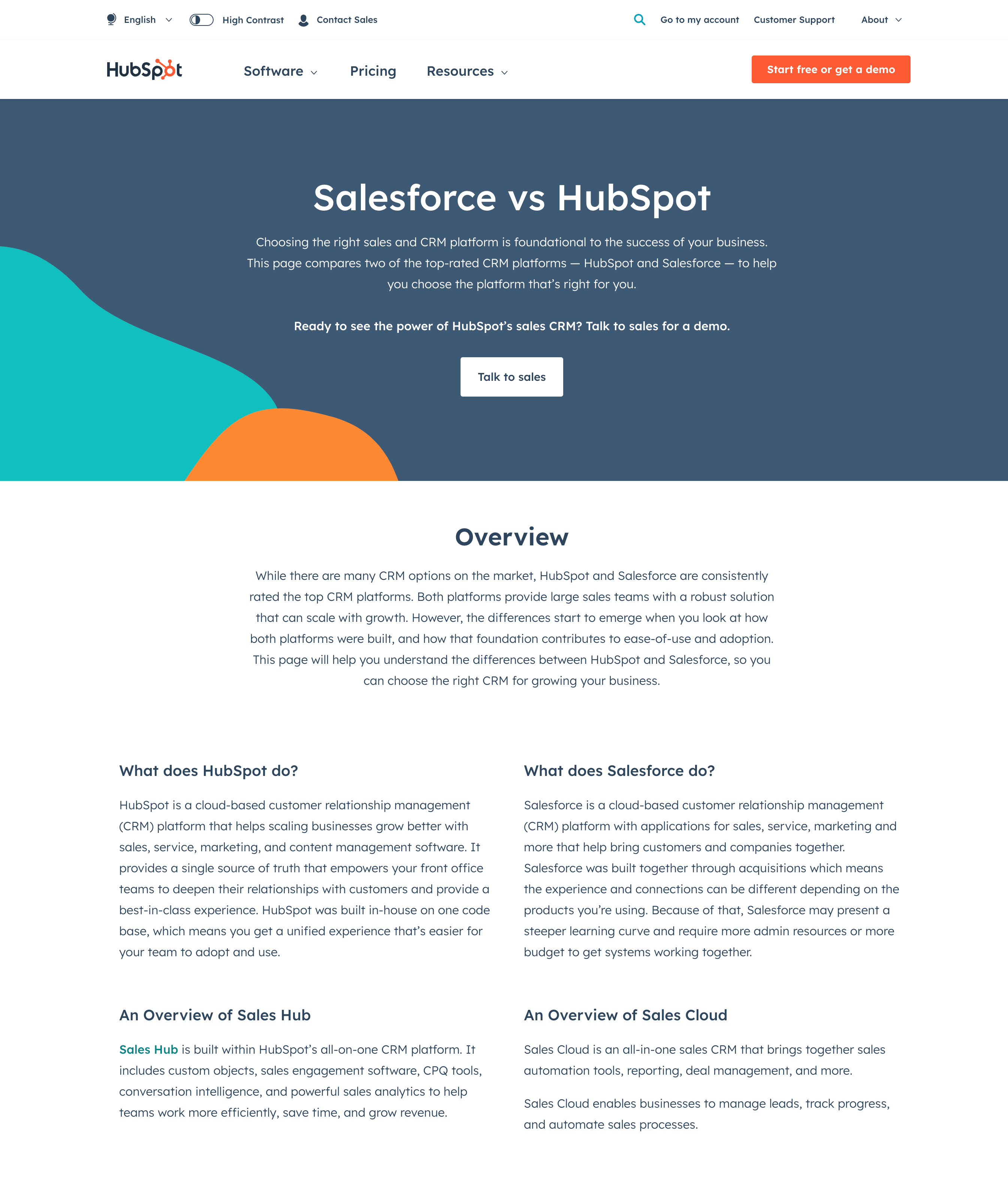
This page gives you a head-to-head comparison of the two platforms to help you understand the benefits and drawbacks of each as well the similarities and differences between the two.
Depending on your industry, these pieces may not be high traffic search queries like the other two approaches, but they are valuable assets your sales teams can use when working with leads who ask the question: “What’s the difference between your company and [insert competitor's name] ?”
2. Build trust in your introduction
One of the best ways to build trust with your audience is to explain what makes you an expert early on. In other words, share what makes you credible so your audience understands why they should listen to you.
Let’s take a look at how this is done in an example from SAMCO’s Best Industrial Water Treatment System Companies for Removing Silica:

This introduction addresses the reader’s problem directly. It mentions that SAMCO does, in fact, offer silica removal services, but they want to ensure the consumer is getting the best care for their individual needs.
This establishes thought leadership and expertise while also showing it’s written in the best interest of the consumer by being transparent about the other options.
3. Share the facts about your competition — good and bad
Now, we get to the question of the hour: What exactly do we say about our current competitors in our content?
Do we slam them and talk about how their products and services are inferior to our own? Or do we sing praises that make them sound like the perfect fit for any consumer?
The answer is...neither.
We’re not going to trash-talk their business, and we’re also not going to glorify it.
We’re simply going to share the facts:
- Who they are
- How long they’ve been in business
- Any awards/certifications they’ve won or compliances they follow
- Their particular specialties or what they’re known for
- Any benefits and any drawbacks
If you want to compliment a competitor, you’re more than welcome to, but sharing anything derogatory can backfire on you, as the trust you’re trying to establish with prospects could begin to slip.
Also, the information you share about each can be as in-depth or shallow as you like.
Let’s take a look at a few examples.
This example comes from IMPACT client Intek Freight & Logistics, a managed transportation services provider. They wrote an article on the Top 10 Managed Transportation Service Companies.
Look at how they mentioned their competitors:
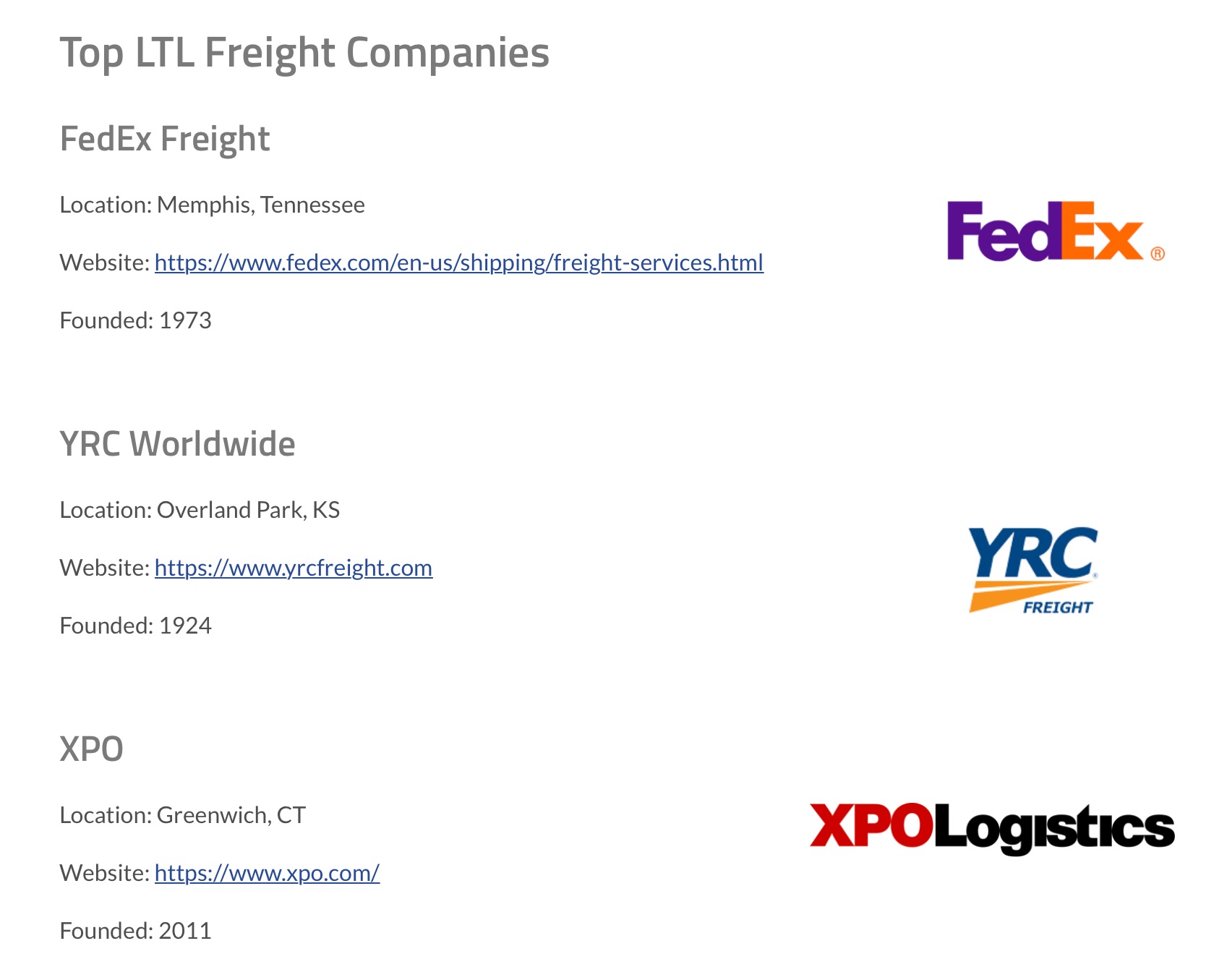
Intek simply added names, logos, locations, websites, and when the companies were founded — nothing editorial or biased.
That doesn’t mean all of your competitor lists should be this simplistic. People do want to have some information, and giving it to them can keep them from researching further in other places.
Take this example from Single Grain, "Best Inbound Marketing Agency: The Top 6 Choices for 2023":
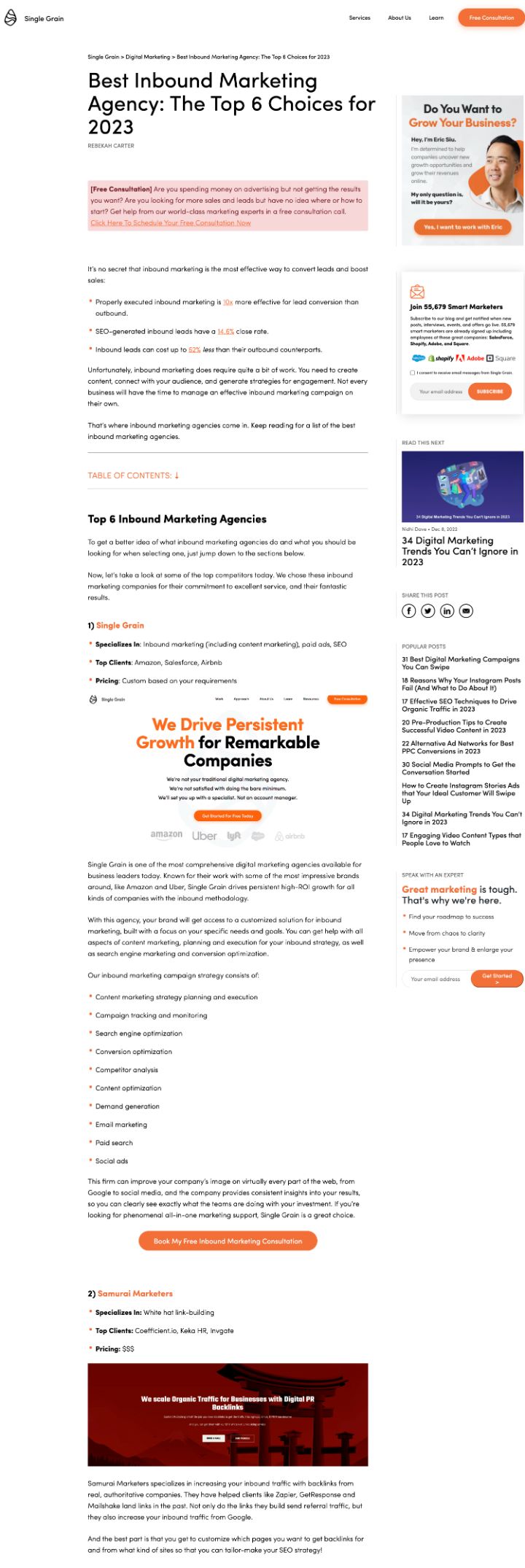
Unlike Intek, Single Grain doesn't shy away from sharing details about their competition. They start with an overview of each competitor's specialities, top clients, and price level, then follow up with a few paragraphs going more in-depth.
If you’re really struggling with what to say about your competitors, go to their websites and check out their “About Us” page. This will give you likely all the information you need.
Note: Another consideration is whether or not to include a link to their website on your page. In the first article by Intek, the competitors are named, and their websites are linked. In the Single Grain article, however, they aren't.
We'll get into the pros and cons of each option a little later.
4. Conclude with actionable direction
Your conclusion should reinforce that your company’s primary objective is consumer education. Recap for them considerations they should keep in mind as they find a company that is a good fit for them and perhaps even tell them how you'd tackle the most common situations.
If you're experiencing X, buy Y.
If your problem is A, then go with B.
This is also an opportunity to reintroduce the services you provide and customers that have found you a good fit for their needs.
Check out this example from IMPACT client Fire & Ice Heating & Air Conditioning in their article, Best HVAC Contractors in Columbus, Ohio.
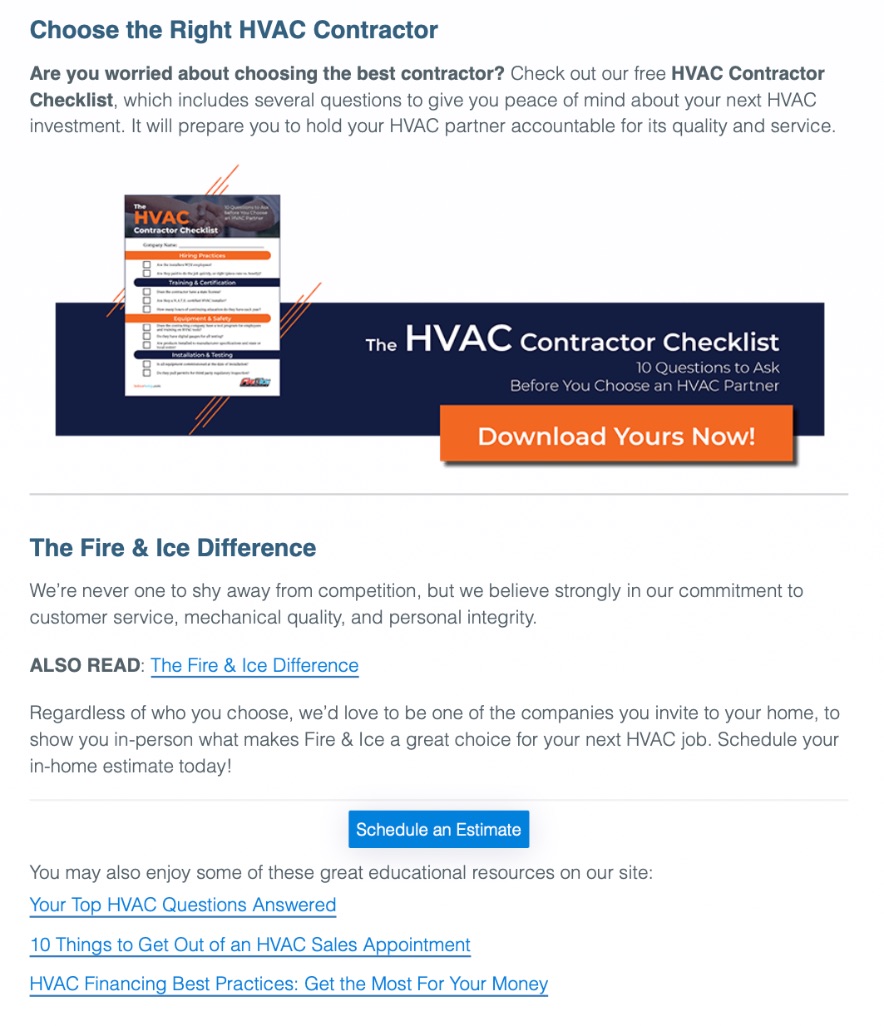
After listing all of the options homeowners have for HVAC companies in Columbus, Ohio, Fire & Ice does a few things:
First, they have a call-to-action for a helpful offer to download a checklist of questions you should ask any contractor. This is not only a valuable offer to the prospect, but it’s also a lead magnet that helps Fire & Ice capture more leads they can nurture.
Then, Fire & Ice throws their hat in the ring by explaining why they feel they’re the best HVAC company in Columbus, giving the reader the opportunity to schedule an estimate right from the page.
Sure, the focus of the article is on the competitors, but at the end of the day, Fire & Ice has come out on top by building trust with their audience through this helpful article.
If there’s any topic that consumers know most companies don’t want to talk about, it’s the fact that there are other companies out there. That’s why this type of article fares so well with consumers and search engines alike.
Pros and cons of linking to competitors
Now, back to our discussion of links. Should you link to your competitor's website?
On the pro side, linking to competitors is great for SEO. Google likes to see you linking to other pages beyond your own site. It’s especially odd to them when you name-drop a company without linking to their domain.
A con is that, by linking to your competitor, you make it easy for readers to leave your site for another. However, I’d argue that, if we’re being honest with ourselves, how hard would it be for someone to check out your competitors’ websites without a link?
They can just as easily open a new tab and search.
For me, the positive SEO benefits and the chance to have the top answer in Google’s search results far outweigh the possibility of someone reading my article and leaving to court my competitor.
But I’ll leave it up to you to make that choice for yourself.
Should you be worried about legal repercussions from writing about your competitors?
When companies are new to this type of content, they often come to us with the same concern: What if my competitors threaten to sue me over what I write?
Just as with all your content, you should aim to be honest and transparent. When writing about your competition, remove bias and opinion. Just share the facts. Facts are not libel.
This is exactly how one of our clients responded to the threat of a lawsuit.
IMPACT client Yale Appliance is a Massachusetts-based retailer selling direct to consumers, and they've been threatened with lawsuits in the past.
They sell thousands of kitchen appliances every year, and they also perform service calls. They started tracking those service calls and seeing which brands needed to be fixed most often.
Then, Yale published its data in an article titled Most Reliable Appliance Brands, showing which brands were the most and least likely to break down.

Major manufacturers threatened lawsuits. (Although brands like Whirlpool and Bosch are not competitors of Yale, this anecdote has relevance.) But Yale stood by its numbers. They were not slandering these brands, just offering facts from the front lines: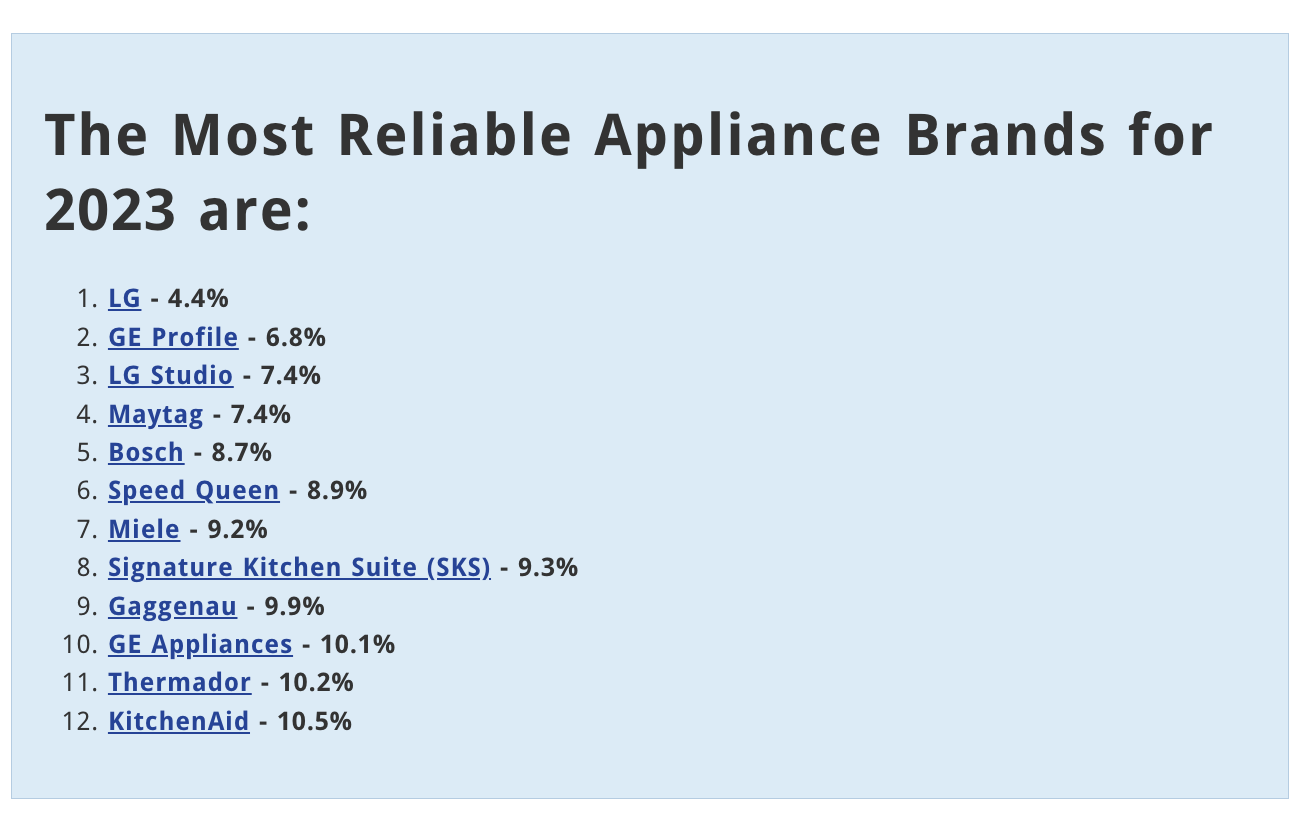
When Yale pointed out they were just reporting facts, the lawsuits were withdrawn.
Each year, Yale updates this list, based on its most recent data, and it’s a good reminder that writing about your competition should be objective and fact-based.
If it gives you peace of mind, check with a legal expert before you publish anything you’re concerned about. See if what you’ve written could be considered libelous. If you’re being factual, you should have nothing to worry about.
Now that that’s out of the way, let’s dive into how you actually write these articles.
So, what’s next?
I know, writing about your competitors can seem scary and I'd be lying to you if I said it didn't require a bit of finesse, but with the tips above and your audience's best interest in mind, you'll be well on your way to driving more traffic, generating more leads, and most importantly, building more trust.
Need more help creating competitor content or other sales enablement content? Check out our free course, "How to Write the Big 5" to learn how to tackle the five most in-demand subject areas for buyers in your content strategy.


Order Your Copy of Marcus Sheridan's New Book — Endless Customers!